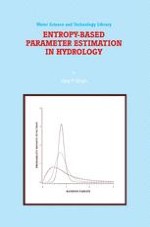1998 | OriginalPaper | Buchkapitel
Weibull Distribution
verfasst von : Vijay P. Singh
Erschienen in: Entropy-Based Parameter Estimation in Hydrology
Verlag: Springer Netherlands
Enthalten in: Professional Book Archive
Aktivieren Sie unsere intelligente Suche, um passende Fachinhalte oder Patente zu finden.
Wählen Sie Textabschnitte aus um mit Künstlicher Intelligenz passenden Patente zu finden. powered by
Markieren Sie Textabschnitte, um KI-gestützt weitere passende Inhalte zu finden. powered by
The Weibull distribution is commonly used for frequency analysis as well as risk and reliability analysis of the life times of systems and their components. Its applications have been reported frequently in hydrology and meteorology. Grace and Eagleson (1966) fitted this distribution to the wet and dry sequences and obtained satisfactory results. Rao and Chenchayya (1974) applied it to short-term increment urban precipitation characteristics in various parts of the U.S.A. and obtained satisfactory fit to the durations of wet and dry periods as well as other characteristics. Singh (1987) derived the Webull distribution and estimated its parameters using the principle of maximum entropy (POME). For the precipitation data used, he found POME-based parameter estimates to be either superior or at least comparable to those obtained with the methods of moments and maximum likelihood. Nathan and McMahon (1990) considered some practical aspects concerning the application of the Weibull distribution to low-flow frequency analysis on 134 catchments located in southeastern Australia. They examined the relative performance of the methods of moments, maximum likelihood, and probability weighted moments. They found that different estimation methods provided distinct sets of quantile estimates and the differences between estimation methods decreased as the sample size increased. While fitting the Weibull distribution to annual minimum low flows of different durations, Polarski (1989) found that occasionally the frequency distributions for different durations crossed, in which case the distribution parameters were constrained by adding to the likelihood function the conditions to prevent the curves from crossing. Vogel and Kroll (1989) developed probability-plot correlation coefficient (PPCC) tests for the Weibull distribution. He then used PPCC tests to discriminate among both competing distributional hypotheses for the distribution of fixed shape and competing parameter estimation methods for distributions with variable shape. Durrans (1996) applied the Weibull distribution to obtain estimates of low-flow quantiles, such as 7-day, 10-year low flow. For developing a stochastic flood model Eknayake and Cruise (1993) compared Weibull and exponentially-based models for flood exceedances. They found that the Weibullbased model possessed predictive properties to those of the exponential model when samples exhibited coefficients of variation less than 1.5 and sample sizes were on the order of two events per year. Using Monte Carlo simulation, Singh et al. (1990) made a comparative evaluation of different estimators of the Weibull distribution parameters, including the methods of Moments, probability-weighted moments, maximum likelihood (MLE), least squares, and POME, with the objective of identifying the most robust estimator. Their analysis showed that MLE and POME demonstrated the most robustness.
